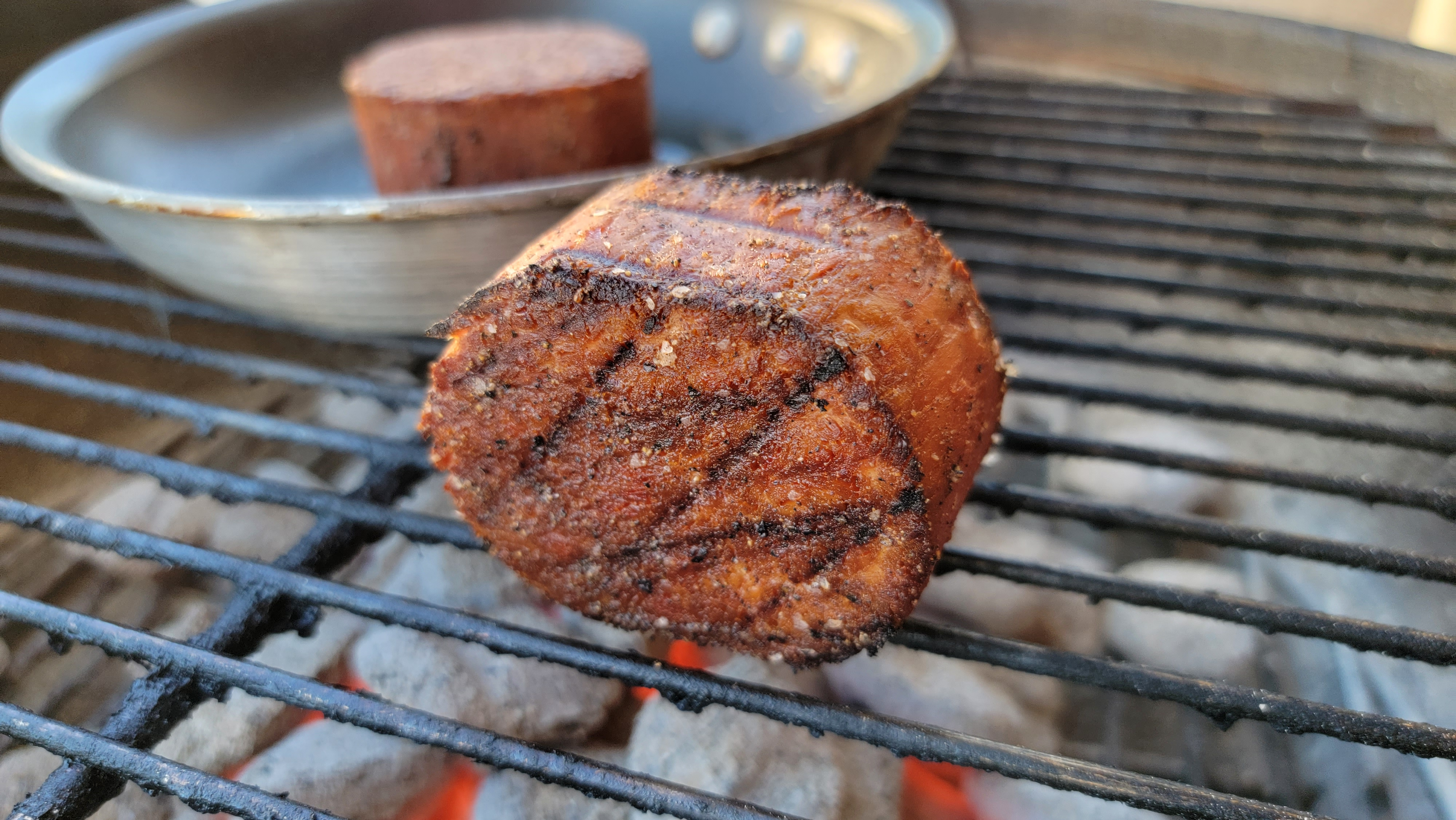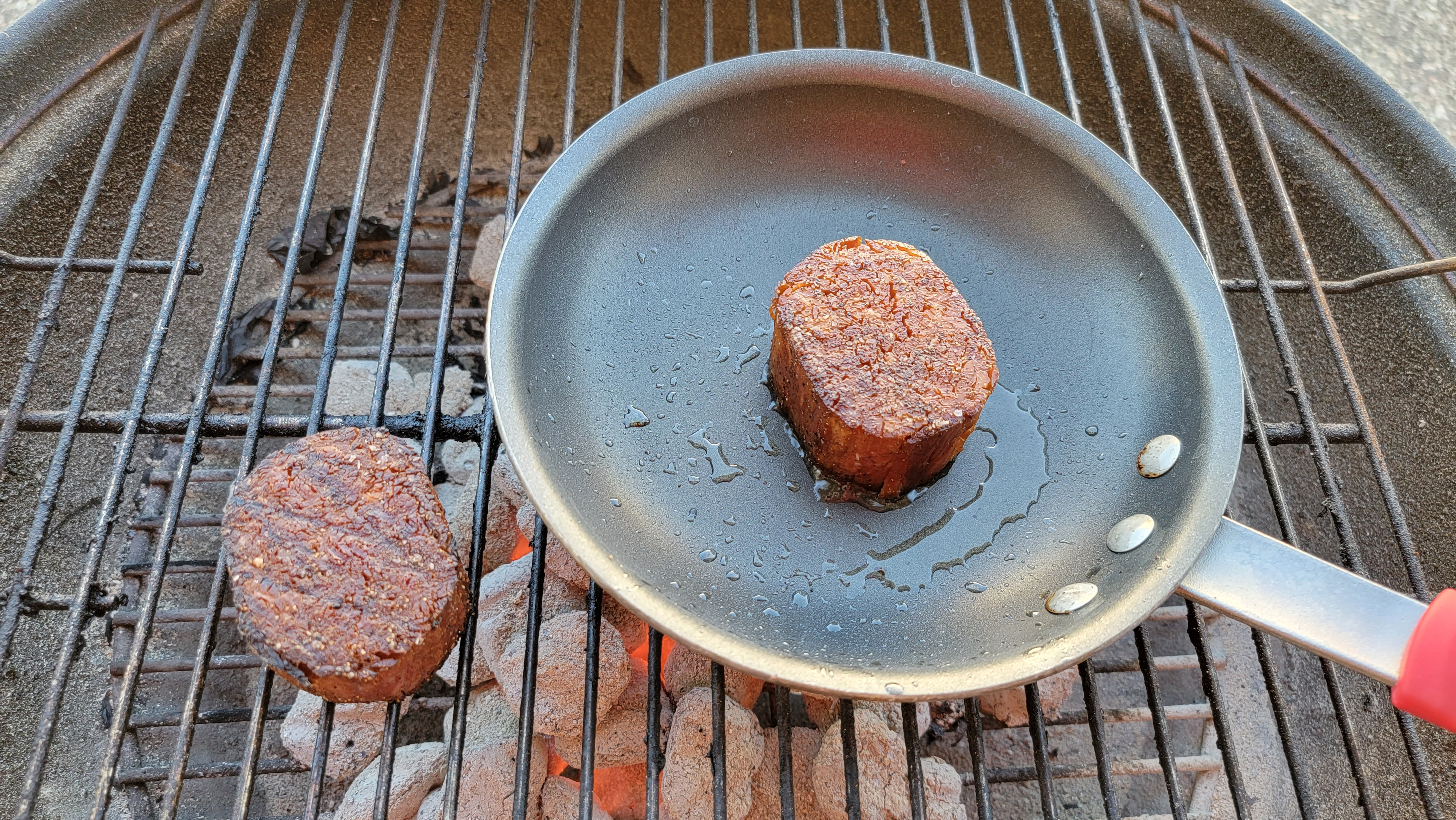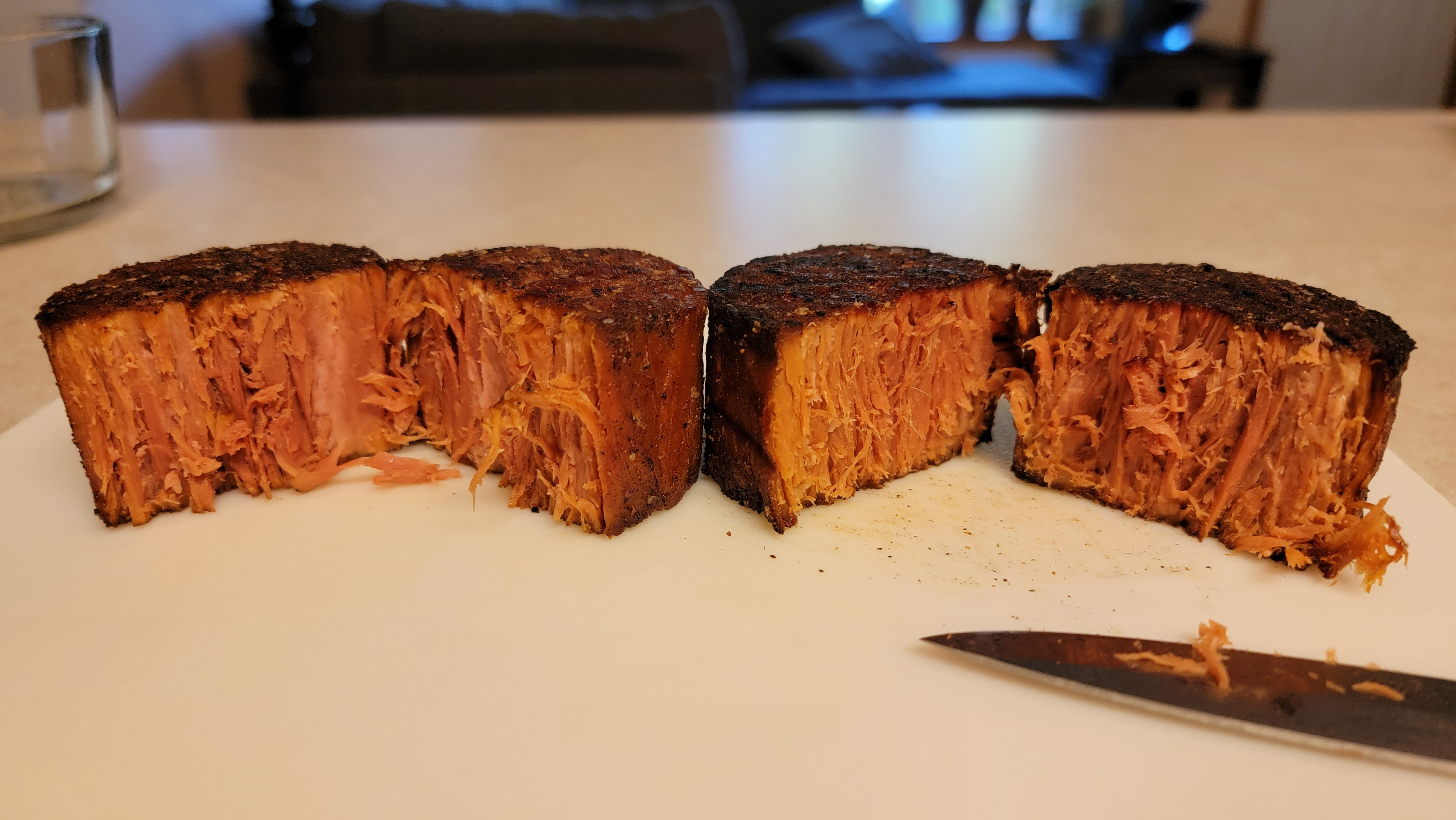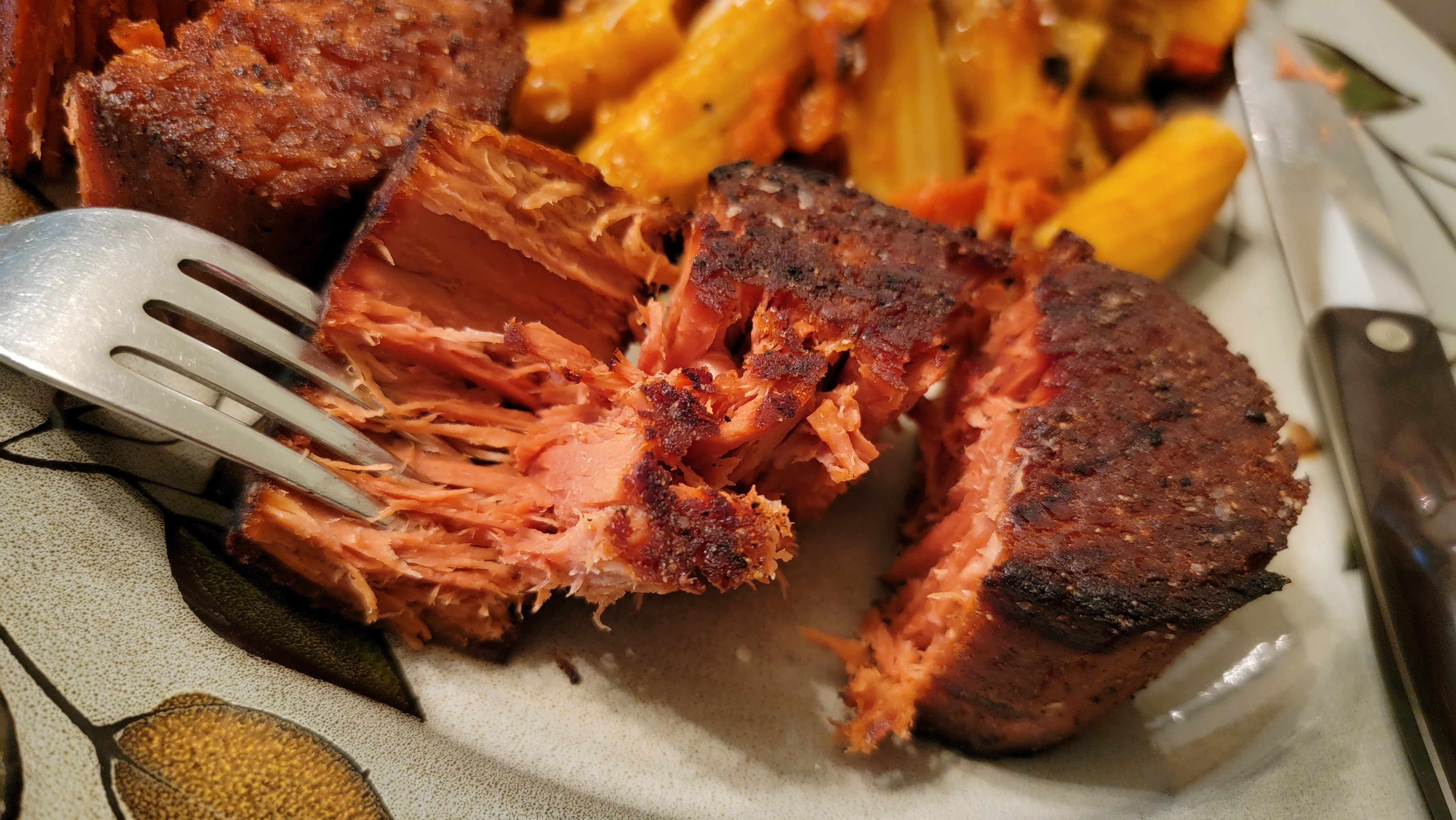This Plant-Based Filet Mignon Told Beautiful Lies To My Palate
Do these expensive steak alternatives have a flavor to match the price point?
I like meat. I like the way it tastes, the way it smells, and the variety of dishes in which it can be enjoyed. But I also happen to like eating plants and trying to make responsible choices for the planet. So, when Juicy Marbles popped onto my radar, I was immediately intrigued.
These plant-based steaks had the look of baffling deliciousness, with photos highlighting a well-marbled crust and a striated interior. Also, the Juicy Marbles website and its social media pages seemed to embrace the brashness of its labeling.
"In a world so painfully serious, and yet so ridiculous," it says, "you know it was only a matter of time before a plant-based filet mignon would become a thing."
Painting that kind of target on your back is also a good way to get crushed, especially when the product itself sells for around $10 per quarter-pound cut. To its credit, Juicy Marbles seems to be aware of this. When I reached out to see if the company would be willing to send over a pack for taste-testing, reps expressed nothing but confidence. A few days passed, a box full of dry ice arrived, and four chunks of plant-based protein headed for the grill.

Meat-stery Science Theater 9000
But first, a quick examination of the package. If you look at the ingredients, you'll see some regulars in the faux-meat scene: Soy protein concentrate, wheat protein isolate, sunflower oil, natural flavors, beetroot powder, kappa carrageenan, etc. So how does Juicy Marbles spin these into its own particular blend? I asked, and here's how the brand responded:
"Using proprietary protein texturizing technology, thanks to the brand's patent-pending 'Meat-o-Matic 9000' Juicy Marbles is able to create this incredible product! Their innovation enables them to create premium, prime grade cuts of meat, with full control over the shape, texture, marbling, flavors, aromas and nutrition."
That's cute and all, but some insight into exactly how the not-sausage is made would be interesting. But I get that it's a trade secret, and I don't begrudge Mr. Marbles his privacy. What really matters, after all, is the taste.
Cooking a faux filet mignon
So, how do we cook these thick chunks of plant? I enjoy both pan-fried and grilled steaks, and it seemed only natural to try both methods at once. I fired up the charcoal, poured some oil into a pan, and got to searing.
My grill game is fairly dialed in, but I'll admit I had concerns. Juicy Marbles claims that its "plant-meat enables rapid crust development resulting in a signature crisp with gentle sweet undertones." This may be, but what about the interior? The packaging recommends cooking the pucks to an internal temperature of 165 degrees Fahrenheit, which would absolutely nuke a genuine filet mignon. Nay, says the website: "The centre always remains soft, like a gorgeous medium rare steak."
After about eight minutes and multiple flips, my meat thermometer indicated that the steaks had reached the desired heat. And the crusts, true to the ad copy, formed up rather beautifully. A quick rest, a cross-section, and it was time to dig in.
How does Juicy Marbles filet mignon taste?
Juicy Marbles is the best tasting meat alternative I've encountered, and I've tried a lot of them. Immediately upon biting into this steak, my tongue sent the familiar signal to my brain: "This is tasty bovine." The texture, flavor, and overall mouthfeel of the Juicy Marbles is the closest approximation to actual beef that I've had the pleasure to eat.
Which cut of beef, however, is a trickier question. The texture lies somewhere between pot roast and brisket. The flavor—and this is going to sound weird, but I mean it in the best possible way—reminded me of corned beef or the highest-quality canned tuna. Not in the manner of funkiness, but in the unctuous nature of the flesh. Funktuous. Is that a word?
The fork-tender interior lived up to its promised moistness in both pan-seared and grilled iterations. I served the pair with some leftover mushroom and tomato pasta, creating one of the richest vegetarian dinners I've ever enjoyed.
But one person's opinion doesn't a quality product make. So, I grilled up the other two along some burgers, brats, and an actual steak at a small gathering of friends.
"You could have fooled me," said one after tasting the steak, and the others expressed similar thoughts. Another individual complimented the texture, but did mention that the flavor was a little too "cat-foody" for their liking. And upon reflection, maybe that holds some crossover with my tuna comment above. But for myself and the others, the taste was definitely on the beefier side.

The price and potential of plant-based steak
Juicy Marbles offers several recipes on its website. Each of these looks interesting, but I'd like to try the steak with some mashed potatoes and a good mushroom and onion gravy. The shreddable nature of this "meat" would also make it perfect for sandwiches, tacos, or a number of other applications. I even tossed some of the grilling leftovers onto a pizza, and the results were outstanding.
But all gushing aside, are these worth the hefty price of $40 per foursome and $20 for shipping? That works out to a whopping $15 per "steak." I'll admit, this is more than I'd generally be willing to pay. However, the cost of beef is stratospherically high right now, especially if you're after a real filet mignon. And having them delivered to your door is a welcome convenience. So, while I wouldn't call these an everyday expenditure, there is a case to be made for their value.
If nothing else, I'm a little in awe of the science on display here. Juicy Marbles has produced something that cooks, smells, and tastes like a genuine hunk of steer. If the company's "Meat-o-Matic 9000" represents the next step in protein alternatives—and if they can scale up production and lower prices—then the future of plant-based flavor looks very bright indeed.



